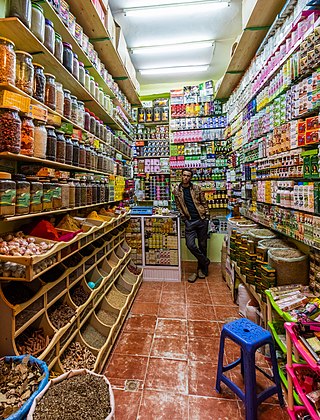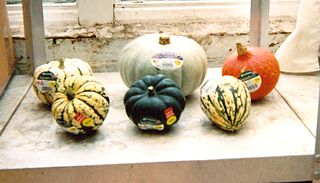Related Research Articles

Marketing is the process of exploring, creating, and delivering value to meet the needs of a target market in terms of goods and services; potentially including selection of a target audience; selection of certain attributes or themes to emphasize in advertising; operation of advertising campaigns; attendance at trade shows and public events; design of products and packaging attractive to buyers; defining the terms of sale, such as price, discounts, warranty, and return policy; product placement in media or with people believed to influence the buying habits of others; agreements with retailers, wholesale distributors, or resellers; and attempts to create awareness of, loyalty to, and positive feelings about a brand. Marketing is typically done by the seller, typically a retailer or manufacturer. Sometimes tasks are contracted to a dedicated marketing firm or advertising agency. More rarely, a trade association or government agency advertises on behalf of an entire industry or locality, often a specific type of food, food from a specific area, or a city or region as a tourism destination.

Retail is the sale of goods and services to consumers, in contrast to wholesaling, which is sale to business or institutional customers. A retailer purchases goods in large quantities from manufacturers, directly or through a wholesaler, and then sells in smaller quantities to consumers for a profit. Retailers are the final link in the supply chain from producers to consumers.

In marketing, a product is an object, or system, or service made available for consumer use as of the consumer demand; it is anything that can be offered to a market to satisfy the desire or need of a customer. In retailing, products are often referred to as merchandise, and in manufacturing, products are bought as raw materials and then sold as finished goods. A service is also regarded as a type of product.
Marketing strategy is an organization's promotional efforts to allocate its resources across a wide range of platforms, channels to increase its sales and achieve sustainable competitive advantage within its corresponding market.

Consumer behaviour is the study of individuals, groups, or organisations and all the activities associated with the purchase, use and disposal of goods and services. Consumer behaviour consists of how the consumer's emotions, attitudes, and preferences affect buying behaviour. Consumer behaviour emerged in the 1940–1950s as a distinct sub-discipline of marketing, but has become an interdisciplinary social science that blends elements from psychology, sociology, social anthropology, anthropology, ethnography, ethnology, marketing, and economics.
User innovation refers to innovation by intermediate users or consumer users, rather than by suppliers. This is a concept closely aligned to co-design and co-creation, and has been proven to result in more innovative solutions than traditional consultation methodologies.

Cosmetic advertising is the promotion of cosmetics and beauty products by the cosmetics industry through a variety of media. The advertising campaigns are usually aimed at women wishing to improve their appearance, commonly to increase physical attractiveness and reduce the signs of ageing.
In the field of consumer behavior, an impulse purchase or impulse buying is an unplanned decision by a consumer to buy a product or service, made just before a purchase. One who tends to make such purchases is referred to as an impulse purchaser, impulse buyer, or compulsive buyer. Research findings suggest that emotions, feelings, and attitudes play a decisive role in purchasing, triggered by seeing the product or upon exposure to a well crafted promotional message.
A lifestyle brand is a brand that attempts to embody the values, aspirations, interests, attitudes, or opinions of a group or a culture for marketing purposes. Lifestyle brands seek to inspire, guide, and motivate people, with the goal of making their products contribute to the definition of the consumer's way of life. As such, they are closely associated with the advertising and other promotions used to gain mind share in their target market. They often operate from an ideology, hoping to attract a relatively high number of people and ultimately become a recognised social phenomenon.
A target audience is the intended audience or readership of a publication, advertisement, or other message catered specifically to said intended audience. In marketing and advertising, it is a particular group of consumer within the predetermined target market, identified as the targets or recipients for a particular advertisement or message. Businesses that have a wide target market will focus on a specific target audience for certain messages to send, such as The Body Shops Mother's Day advertisements, which were aimed at the children and spouses of women, rather than the whole market which would have included the women themselves. A target audience is formed from the same factors as a target market, but it is more specific, and is susceptible to influence from other factors. An example of this was the marketing of the USDA's food guide, which was intended to appeal to young people between the ages of 2 and 18.
In behavioral economics, willingness to pay (WTP) is the maximum price at or below which a consumer will definitely buy one unit of a product. This corresponds to the standard economic view of a consumer reservation price. Some researchers, however, conceptualize WTP as a range.

Food marketing brings together the food producer and the consumer through a chain of marketing activities.

Digital marketing is the component of marketing that uses the Internet and online-based digital technologies such as desktop computers, mobile phones and other digital media and platforms to promote products and services. Its development during the 1990s and 2000s changed the way brands and businesses use technology for marketing. As digital platforms became increasingly incorporated into marketing plans and everyday life, and as people increasingly used digital devices instead of visiting physical shops, digital marketing campaigns have become prevalent, employing combinations of search engine optimization (SEO), search engine marketing (SEM), content marketing, influencer marketing, content automation, campaign marketing, data-driven marketing, e-commerce marketing, social media marketing, social media optimization, e-mail direct marketing, display advertising, e-books, and optical disks and games have become commonplace. Digital marketing extends to non-Internet channels that provide digital media, such as television, mobile phones, callbacks, and on-hold mobile ring tones. The extension to non-Internet channels differentiates digital marketing from online marketing.

Seasonal packaging is a way of marketing a product and sparking sales in consumer segments that infrequently buy the product, by wrapping the product in a package closely related to seasons or holidays such as Valentine's Day, Easter, Mother's Day, Memorial Day, the Fourth of July, Labor Day, back-to-school, Halloween, Thanksgiving, Christmas and New Year's. It is efficient as a marketing tool.
Consumer ethnocentrism is a psychological concept that describes how consumers purchase products based on country of origin.

A brand is a name, term, design, symbol or any other feature that distinguishes one seller's good or service from those of other sellers. Brands are used in business, marketing, and advertising for recognition and, importantly, to create and store value as brand equity for the object identified, to the benefit of the brand's customers, its owners and shareholders. Brand names are sometimes distinguished from generic or store brands.

Social media marketing is the use of social media platforms and websites to promote a product or service. Although the terms e-marketing and digital marketing are still dominant in academia, social media marketing is becoming more popular for both practitioners and researchers. Most social media platforms have built-in data analytics tools, enabling companies to track the progress, success, and engagement of ad campaigns. Companies address a range of stakeholders through social media marketing, including current and potential customers, current and potential employees, journalists, bloggers, and the general public. On a strategic level, social media marketing includes the management of a marketing campaign, governance, setting the scope and the establishment of a firm's desired social media "culture" and "tone."
Word-of-mouth marketing differs from naturally occurring word of mouth, in that it is actively influenced or encouraged by organizations. While it is difficult to truly control WOM, research has shown that there are three generic avenues to 'manage' WOM for the purpose of WOMM:
Consumer confusion is a state of mind that leads to consumers making imperfect purchasing decisions or lacking confidence in the correctness of their purchasing decisions.

Joannes Evangelista Benedictus Maria "Jan-Benedict" Steenkamp is a marketing professor and author. He is the Knox Massey Distinguished Professor of Marketing at Kenan-Flagler Business School, University of North Carolina at Chapel Hill. He is also the co-founder and executive director of AiMark, a global center studying key marketing strategy issues. Steenkamp is the author of Time to Lead, Retail Disruptors, Global Brand Strategy, Brand Breakout and Private Label Strategy. He is one of the most cited scholars in business and marketing.
References
- ↑ Tellis, Gerard J.; Yin, Eden (2010). Consumer Innovativeness. Wiley International Encyclopedia of Marketing. doi:10.1002/9781444316568.wiem03009. ISBN 9781405161787.
- ↑ Steenkamp, Jan-Benedict; Hofstede, Frenkel ter; Wedel, Michel (1999). "A Cross-National Investigation into the Individual and National Cultural Antecedents of Consumer Innovativeness". Journal of Marketing. 63 (2): 55–69. doi:10.2307/1251945. JSTOR 1251945.
- ↑ Goldsmith, Ronald; Hofacker, Charles (1991). "Measuring consumer innovativeness". Journal of the Academy of Marketing Science. 19 (3): 209–221. doi:10.1007/BF02726497.
- ↑ Grewal, Rajdeep, Raj Mehta, and Frank R. Kardes. "The role of the social-identity function of attitudes in consumer innovativeness and opinion leadership." Journal of Economic Psychology 21, no. 3 (2000): 233-252.